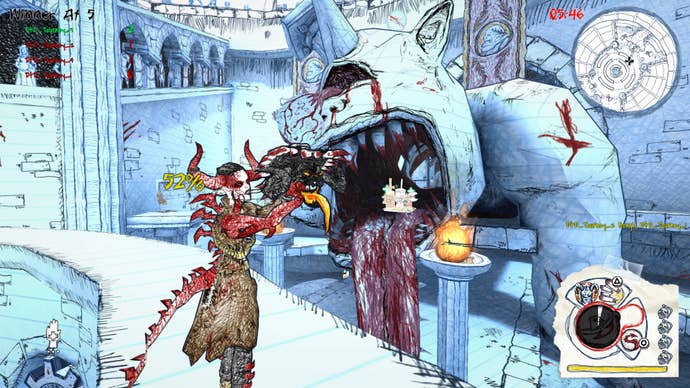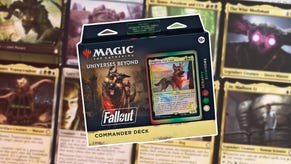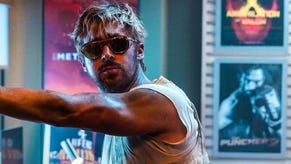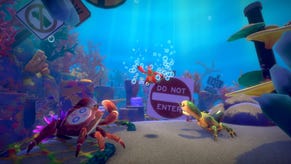Drawn to Death PS4: Seriously Weird-Looking, Surprisingly Deep
Jaz plays David Jaffe's shooter/brawler, Drawn to Death, and then speaks to him about his latest game.
This article first appeared on USgamer, a partner publication of VG247. Some content, such as this article, has been migrated to VG247 for posterity after USgamer's closure - but it has not been edited or further vetted by the VG247 team.
Drawn to Death is the creation of The Bartlet Jones Supernatural Detective Agency, a developer headed up by veteran games director David Jaffe, best known for the first two God of War titles, and the Twisted Metal series. It's certainly strange-looking – a third-person arena shooter/brawler whose characters and backdrops look like they've been lifted straight from the notebook doodles of a slightly demented teenager.
It gives the game a distinct look that's surreal – and feels almost nightmarish. Characters are very unusual, and include a half-shark, half woman ninja through a female demon in a cowboy outfit to an anthropomorphic pig with sharp teeth. All are rendered to look like ink doodles come to life, and it's a very cool effect.
The game pits four players against one another in a battle that plays out in one of a variety of arenas. Their design feels very 90's in some respects: there are Quake-style ramps and platforms everywhere, and each seems to riff on different themes. We played a couple: one called "Flood" that seemed to be inspired by elements of global warming, while another, "Coliseum" was circular and incorporated Roman columns and archways, along with a drawn crowd looking down from a raised gallery.
Like the characters, everything feels like it's been taken from the sketchbook of someone who has a decent, but not outstanding talent for art. The sky is comprised of pages from a notebook, complete with scribbles and doodles, and lines and perspectives aren't always straight. It took a little while to get used to the rather crazy-feeling style, but once I acclimatized to its limited palette and wonky rendering, it really grew on me.

Drawn to Death's gameplay is deceptive. It initially feels like a third-person shooter. You can choose from a variety of different weapons, each of which has its own strengths and weaknesses that seem to be balanced around fundamentals such as damage, reload time, difficulty to aim and manage, and number of uses. Like the characters, the weapons are slightly unhinged. For example, there's a rocket-propelled grenade launcher called a JRPG that takes the form of a shoulder-mounted console that fires cartridges at enemies, a guitar that can be used as an axe, and a monkey that sits on your back, craps into its hands and hurls it at enemies. Subtle and tasteful, this game is not. Inventive and weird, it most certainly is.
During my session, I chose slightly more mundane tools: a sniper gun that worked just like a sniper gun, a dragon that tucked under my arm and shot powerful fireballs, and a dodgeball launcher that was quite entertaining to use. Initially, I played the game like a third-person shooter, but it's more than that. Each character has special passives, and close-up melee moves that they can break out when they close the gap with another player to quite devastating effect, making the game a brawler-shooter hybrid that has tactically diverse gameplay. With the different weapons each delivering unique effects, it's possible to build characters with a wide variety of playstyles, from a more ranged focus to close-up melee – or something in between.
Drawn to Death's action is fast, but players have reasonably large health pools, so there's space to breathe and chase one another around. There are also plenty of power-ups dotted around the environment, as well as health refills, new weapons and other advantages, which makes fighting a back-and-forth game that's rich and full of incident.

Ultimately, I had fun playing Drawn to Death. I did find the game tricky to get to grips with initially. Despite running through the training level, the controls aren't particularly intuitive out of the gate. The basics are certainly simple enough to pick up – and that's why I started out playing the game like a shooter, because it's easy to do so – but using special moves takes a lot more practice. I'm looking forward to spending a little more time with the game so see whether I can pick up its more subtle aspects - which there seem to be many.
After our session, I sat down with David Jaffe to talk to him about his creation:
Why did you decide to create a third-person arena shooter/brawler?
"I really love competitive games. Whether it's Hearthstone, card games, video games, or board games, I love pure games. I also love action games and violent games. For me, so many of the shooters have become wonderful about their meta – their upgrades and perks and all of that. I have no complaints about them, and people love them. But what I'm missing and what people on the team are missing on the design front is that we haven't seen much evolution from the moment to moment engagement of players. If I encounter you on a battlefield in Star Wars: Battlefront, all the way back to the original Call of Duty multiplayer, our actual moment to moment engagement hasn't really evolved. What's evolved, besides the wonderful art and so on, is the meta – the upgrades, leveling up, prestige and all that. We were trying to figure out whether we could do a balanced game that didn't have any upgrades so it was more of a pure skill-based game. Could we at least eke out a deeper more mentally engaging experience between one on one or one on two – that's why we only have four players in the game at the same time – because we really want to be able to focus on the exchange in that relationship and bring more mental engagement to it. We weren't seeing that out there, and that's what I really want to be playing. Because that's the stuff that excites me the most – when you're trying to solve a puzzle as well as having an adrenaline moment in an action game. That's the main impetus behind doing a game like this."

These kinds of games live and die on balance. How are you going to tackle this particular issue?
"It's an ongoing job. The main thing we're consistent on is that we want and demand balance. You should never feel you've purchased, rented or unlocked anything in the game that’s better. It's only better in that it might scratch an itch that you as a player might have. The base example I always give is Uncle Joe, a guy in a coffin that you fire. You do 90% damage if you get a direct hit. But the reload time is such, and the amount of ammo you have is on the negative end that we feel that he's more powerful than a machine gun, but the power comes at an expense."
"Another one we have is a monkey called Emily named after Emily Dickinson – there's a whole story about that in the game. She eats bananas and poops, and you can charge up the poop and then throw it. There are four different projectiles: Homing poop, freezing poop, power poop and so on. But we also have a devil monkey that's exactly the same, but more powerful. The balance there is that 25% of the time she'll poop a bomb that you can't get rid of that explodes and does 70% damage to you. I'm okay with things being more powerful as long as it has a cost to it. That applies to everything from special character moves to weapons that you buy to being able to summon a giant hand that can take two points off a character if you kill them. But it's the hardest mechanic to do with that weapon, and it's very easy to avoid if you're paying attention."
"We're never going to be 100% balanced. We're always going to be constantly adjusting and nurturing it in the hopes to get a balance that feels honest."

Drawn to Death is a complex game. How are you going to communicate its many subtleties to the player.
"There are people who just pick the game up and for whatever reason, they're into that. They get what we're trying to do. Although I don't like the word "get" because it implies we've put something forward that only certain people are able to comprehend. I'm not trying to be elitist, but there are people who just engage with it easier. Other people we've seen play the game, and they're trying to play it like a traditional shooter, and they walk away bored. We know we're going to have people like that."
"What I said to Sony is that I wanted to talk to some key game journalists to get the message out there, and then people will know that's what we're trying to do. If they get it they get it, and if they don’t they don't. But I wouldn't have wanted us to make a game that didn't try to do this for a couple of reasons. One: It wouldn't interest me. But beyond that, those games exist and they're already out there. If you want a game that's a lot less dense mechanically, you can totally get served. But I didn't think a game like Drawn to Death was being offered up."
"There's a difference between our intentions and our execution. I don't know whether we've succeeded, and I won't know until it comes out. Even at the intention level, I hope that there are enough players out there who will vibe with this kind of game and are looking for something different. We'll see."

If you're recommending this game to another player, what would you say to them? How would you describe it?
"I would say it's like Quake Arena, Unreal, and Super Smash Bros. Two of those games are really old, and one game is connected correctly, but you have to get under the hood to why Super Smash Bros. is such an accurate touchstone. If you like brawler games like Mortal Kombat, Rocket League, Hearthstone, even MOBAs. There's nothing MOBA about this. But in terms of if you like learning characters and learning nuances and learning how other characters interact with your character, it is."
"What's been hard when we've focus tested this game is that we think – and this is a mistake I've made – is that we should only get shooter players. But we didn't really want only shooter players, because they'll come to the table with a set of expectations that we're not necessarily serving."
"Beyond that, I think the bigger thing to say is that a key reason that we wanted to make the game free to play is that it allows us to sort of say, look, you may not know exactly what this is yet, and we get that the art style is really weird, but we don't want to charge you anything for your time. Which is more valuable than your money, but it's an easier thing to part when you're sitting on a couch on a Sunday wondering what to play."
"So hopefully the game being free to play will allow people to give it a shot. And then with the share button, Twitching, and YouTube-ing and all that… We're not going after Call of Duty numbers – even though we'd love that – but what we would love to do is build a healthy fan base that really likes and engages with this game, and we get to make new stuff for it, and Sony gets to make a profit and feels good about their investment. And one day maybe it might become bigger."
"For me, I believe in this game, I believe in its mechanics, and I believe in its gameplay, and I'm excited and nervous to find out if there are others at the numbers we need that have a similar affection for the game."

How did the aesthetic of the game evolve?
"Drawn to Death started as Stick Figure Shootout. It was always in a notebook, but as we started to build the game, it made sense to make the notebook a high school kid's notebook. And the minute it became a high school kid's notebook, it stopped making sense to do stick figures. He's going to badly draw proportions, misunderstand perspective, and be inconsistent with his pen strokes. As we started to look at the concept art that was directed that way, everybody began to feel that they did that in high school, and their friends did that in high school. Even looking at the cover and book, it felt very honest and genuine. We still look back at the stick figure art, which is quite stylized. I think it's more commercial. It's softer, and friendlier, even though it's still violent. The new style is not that. But I think we see it as more authentic and it feels correct."

I noticed that the game has something called the "Black Market". Can you tell me a little more about that?
"You have to do a number of things to access this, but once you're in, you can buy your way into black skull matches. Certain things in the store are only available if you pay with black skull currency, and you can also pay for normal items with black skulls. Entry into a black market game – and prices may change – will be something like a quarter per battle. And depending on how well you do in the battle, you get a number of black skulls. The better you do, the more skulls you get, and you can use those to buy things. So if you do really well, you can buy a character with black skulls that might normally cost $8 for the price of only $3. You could potentially go over for a black skull item and end up paying $10 for an $8 item, but it won't be much more than the base price of an item or character."
"It's like gambling, but it's not officially gambling because it's a false currency. It's basically a chance to test your skills against other players and get rewarded with new items."
"It's not like there's separate black market games. You just pay for a game, and will get black skulls as a reward for that game depending on how well you do. If you gamble correctly on your skills, and you're a good enough player, you can pay substantially less for items."

Drawn to Death will be free to play. Can you explain a little more about the business model?
"It's a free to play game that's made by a team of people who hates free to play. Free to play, much like upgrades in shooters, to me feel like a really bad, unhealthy road for people who love competitive games. Doesn't mean it's a bad system, but the very nature of it existing in the way it does, it pleases parts of your brain – oh I upgraded and I'm stronger now – but it comes at the cost of the actual moment to moment mechanics of the game. I think it's like comparing it to poker, and suddenly you can see my cards because you upgraded to the x-ray glasses poker card. You might love it for a few minutes, but ultimately the game falls apart for everyone and nobody wants to play it. So it's a case of can we do free to play in a way that excites players, engages and respects them, but doesn't sell power or upgrades but still has enough cool stuff for them to buy that allows us to stay in business with this particular project."
"We're going the cosmetic route, but we're also letting players gamble on their skills. We're also letting players rent things, and when you rent something the actual purchase price comes down. So you don't feel burned. If you rent a shotgun for a dime, and if you like it and it usually costs a $1.50, it'll cost $1.40."
So they're really micro-microtransactions.
"Yeah absolutely!"
Almost like an arcade game?
"The original intent behind it – which didn't really work – is that it was going to be pay to spawn. You get 50 free lives per day, and when you die, you have to pay for more. I don't think gamers would go for that in retrospect."
"This game is willing to bend over backwards and fail before we go down the road of selling power. We didn't have to make a free to play game. I originally wanted to do it all with ads, but the infrastructure just wasn't set up. I have no problem with the Hulu model at all. People don't like ads, and I don’t either, but at the end of the day it's free. So f**king watch the ad. Or don't and do something else."
"But whatever – the point is that it can't come at the expense of the game. And every system in the game is based around making the player feel respected. Hopefully that'll be enough. It may not be. It may come to be that free to play, not because people are evil and greedy, at the end of the day they won't pay for something they don't have to pay for. And in a video game, or in a competitive game, the only thing worth paying for might be a leg up. If that's the case then, that's cool. We didn't hit the target. But this is the way I want to try to hit the target – but that's the only way I want to shoot at the target. Can we do something that's game and player respectful, and we'll see what happens."








